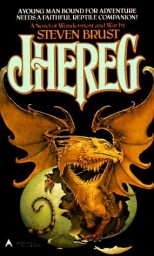 Ace Books had its part in the history of sword and sorcery fiction. The company had published Fritz Leiber’s Fafhrd and the Gray Mouser stories as collections starting in the late 1960s. In the late 1970s, Ace jumped on putting out the twelve volume Conan paperback set.
Ace Books had its part in the history of sword and sorcery fiction. The company had published Fritz Leiber’s Fafhrd and the Gray Mouser stories as collections starting in the late 1960s. In the late 1970s, Ace jumped on putting out the twelve volume Conan paperback set.
Ace was not a big publisher for lone sword and sorcery novels like Zebra Books. It did publish some series through the whole collapse of the genre in the mid-1980s.
One was the Vlad Taltos series by Steven Brust. The first novel Jhereg came out in April 1983. The book had a very nice Steve Hickman cover, mass market paperback, clocked at 239 pages, and sold for $2.50. There was a second printing in May 1983. Two more printings followed in 1984, one in 1987, and one somewhere probably in the 1990s that sold for $5.99.
In 1999, the first three books in the series were combined as a trade paperback omnibus.
The background to the story is Vlad Taltos, a human (called “Easterner”) lives in the unnamed city of the Dragaeran Empire. The Dragaerans are elf-like in having tall stature and exceptionally long lives. Brust’s Dragaerans are more like Michael Moorcock’s Melniboneans than Tolkien’s elves.
The opening scene has a young Vlad Taltos witness an assassination in his father’s restaurant. The next scene has him making a deal with a type of small dragon called a Jhereg to receive an egg. The dragon chick becomes his familiar.
Vlad’s father had spent almost all his money to buy a title to become a member of one of the Dragaeran families, the Jhereg. Vlad takes service with the family as a gopher and eventually becoming an assassin.
The meat of the story is his employment to take out a Dragaeran who absconded with a very large amount of gold before others get the idea that the Jhereg family is a soft target.
I slogged my way through this novel. Here are the reasons. First, the book is written in first person. I hate reading first person stories. One complaint leveled at first person stories is the loss of tension as you know the protagonist is going to make it through. I think this is a fair point. First person narratives also tend to be very dialogue driven and light on the description. You really don’t have much idea of how things look in Jhereg.
Second: Brust is part of a generation heavily influenced by Michael Moorcock. Moorcock has written some good stories but his world building has something to be desired. I burned out on Moorcock pretty quick back in the day. As The Encyclopedia of Fantasy said: “There is a smell of greasepaint to the MM oeuvre.”
Brust first appeared with Jhereg. He did not serve an apprenticeship in the small press magazines of the 1970s.
Brust’s unnamed city in Jhereg reads like a cross between Fritz Leiber’s Lankhmar and Mario Puzo’s The Godfather. The Dragaeran families are set up very much like Mafia families.
I have some moral qualms in having the protagonist as an assassin. Perhaps in the series, Brust has Vlad Taltos only kill those who deserve it. There are also some deus ex machina plot coupons present. People can be brought back to life if the body is taken to a sorcerer in time. Vlad Taltos can teleport himself to locations. There is also some telepathy that Brust calls “psionic contact.” I found these things to be jarring.
The question is: In attempting to making it real, does the fiction at some point cease to be fantasy or fantasy as we know it? I will create a new term for this type of fantasy offshoot and call it “scuzzy fantasy.”
I give Jhereg a three out of five rating. Interestingly, I could not find a decent used copy of the novel locally. They were pretty beat up with cracked spines and bent covers. I had to buy the three volume omnibus, which means I have two more novels to slog through. The series must have proven popular as it is still in print. Brust took the series from Ace to Tor with book eight, which has continued to use Steve Hickman covers.
I liked Jhereg quite a bit, but it is of course ‘low fantasy’.
Somewhat interestingly, Dragaera started out as the roleplaying campaign of another guy. It can be seen, I think, in that the setting seems pretty well played through, and also in — cough — the names and behaviors of the friends of Vlad (I nearly wrote friendly NPCs). Still, I think Brust did a good job in those early stages. Later books in that series get a bit aimless and boring IMO, though I’ve loyally read them all.
http://dragaera.info/mailinglists/dragaera/archive/2003q1/006086.html
You could also take a look at Brusts ‘Three Musketeers in Dragaera’. At first I didn’t like them; now I think they actually were some of the better work. Starts with The Phoenix Guard and illuminates quite a bit of background, with a very different feel compared to the Vlad books.
The article is informative. I mentions dates of different printings, yet fail to say how many in each printing. Is it possible to find how many books were printed in total? (For each title, not the whole series.) Of so, where.
Thanks in advance.
The LEGO Roboticist